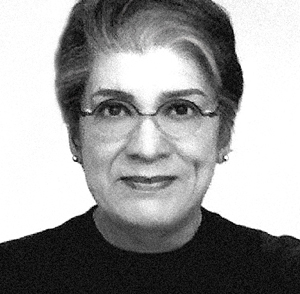
Yolanda Margarita López was an American painter, printmaker, educator, and film producer. She was known for her Chicana feminist works focusing on the experiences of Mexican-American women, often challenging the ethnic stereotypes associated with them. Lopez was recognized for her series of paintings which re-imagined the image of the Virgen de Guadalupe. Her work is held in several public collections including the Smithsonian American Art Museum, the San Francisco Museum of Modern Art, and the Los Angeles County Museum of Art.
Ester Hernández is a California Bay Area Chicana visual artist recognized for her prints and pastels focusing on farm worker rights, cultural, political, and Chicana feminist issues.

Self-Help Graphics & Art, Inc. is a community arts center in East Los Angeles, California, United States. The building is a mix Beaux-Arts and vernacular architecture built in 1927, and was designed by Postle & Postle. Formed during the cultural renaissance that accompanied the Chicano Movement, or Self Help, as it is sometimes called, was one of the primary centers that incubated the nascent Chicano art movement, and remains important in the Chicano art movement, as well as in the greater Los Angeles community, today. SHG also hosts musical and other performances, and organizes Los Angeles's annual Day of the Dead festivities. Throughout its history, the organization has worked with well-known artists in the Los Angeles area such as Los Four and the East Los Streetscapers, but it has focused primarily on training and giving exposure to young and new artists, many of whom have gone on to national and international prominence.

Laura Molina is an American artist, musician, and actress from Los Angeles, California. Molina is perhaps best known for her Naked Dave paintings. She is also the creator of Cihualyaomiquiz, The Jaguar, a self-published comic book printed under Molina's own Insurgent Comix imprint.

Alfredo de Batuc is a Mexican American artist who was born in Mexico in 1950 but has been living and working in Los Angeles, California since 1975. De Batuc has worked in a variety of mediums including drawing, painting, ceramics, silkscreen and lithograph prints, and has also been commissioned for several special projects such as murals in the Los Angeles area. His work with Self Help Graphics during its early years and during the height of the Chicano Movement connects de Batuc to a rich history of political and artistic activism. Through this work and activism, de Batuc helped to create a collective Mexican American cultural pride and identity that was integral to the goals of the Chicano Movement. In 2005, Alfredo de Batuc was stricken with a severe case of Guillain–Barré syndrome, which has kept him from active life since, and from which he is slowly recovering.

Judithe Hernández is an American artist and educator, she is known as a muralist, pastel artist, and painter. She a pioneer of the Chicano art movement and a former member of the art collective Los Four. She is based in Los Angeles, California and previously lived in Chicago.

Melanie Cervantes is a Xicana artist and activist based in the Bay Area.

The Chicano Art Movement represents groundbreaking movements by Mexican-American artists to establish a unique artistic identity in the United States. Much of the art and the artists creating Chicano Art were heavily influenced by Chicano Movement which began in the 1960s.
Yreina Cervantez is an American artist and Chicana activist who is known for her multimedia painting, murals, and printmaking. She has exhibited nationally and internationally, and her work is in the permanent collections of the Smithsonian American Art Museum, The Mexican Museum, the Los Angeles County Museum, and the Los Angeles Museum of Contemporary Art.
Barbara Carrasco is a Chicana artist, activist, painter and muralist. She lives and works in Los Angeles. Her work critiques dominant cultural stereotypes involving socioeconomics, race, gender and sexuality, and she is considered to be a radical feminist. Her art has been exhibited nationally and internationally. Her work was exhibited in the 1990-1993 traveling exhibition Chicano Art: Resistance and Affirmation.
Sonia Amalia Romero is an American artist, she is known for her printmaking, mixed media linocut prints, murals, and public art based in Los Angeles. She is known for depicting Los Angeles, Latin American imagery, and Chicano themes in her work.

Chicana art emerged as part of the Chicano Movement in the 1960s. It used art to express political and social resistance through different art mediums. Chicana artists explore and interrogate traditional Mexican-American values and embody feminist themes through different mediums such as murals, painting, and photography. The momentum created from the Chicano Movement spurred a Chicano Renaissance among Chicanas and Chicanos. Artists voiced their concerns about opression and empowerment in all areas of race, gender, class, and sexuality. Chicana feminist artists and Anglo-feminist took a different approach in the way they collaborated and made their work during the 1970's. Chicana feminist artists utilized artistic collaborations and collectives that included men, while Anglo-feminist artists generally utilized women-only participants.Art has been used as a cultural reclamation process for Chicana and Chicano artists allowing them to be proud of their roots by combining art styles to illustrate their multi-cultured lives.
Margarita “Mita” Cuaron is a Chicana curator, visual artist, social activist, educator, and a registered nurse. Born and raised in East Los Angeles, Cuaron utilizes a range of mediums in her artworks such as screen printing, printmaking, watercolor, mixed media, paper mache and more. Margarita “Mita” Cuaron was an active participant in the Chicano Movement and in the 1968 “blowouts” in East Los Angeles schools of the L.A. Unified School District.
Laura E. Alvarez born August 8, 1969, in Huntington Beach, California is a visual artist.
Patricia "Pat" Gomez is a Chicana visual artist based in Los Angeles best known for incorporating text within her art. She is currently the Civic Art Project Manager at Los Angeles County Department of Arts and Culture.
Dalila Paola Méndez, is an American visual artist of Guatemalan/Nicaraguan/Salvadoran descent.
Angélica Becerra is an activist visual artist who primarily works in watercolor and digital media.
Graciela Carrillo is a Chicana artist and muralist in San Francisco and member of the all-female Chicana/Latina artist group Mujeres Muralistas. She is a co-founder of Galería de la Raza, a gallery utilized to showcase the everyday lives of the Chicano community through art during the Chicano Civil Rights movement through the Chicano muralist movement.
Cristina Cardenas is a painter, printmaker, and lithographer known for paying tribute to Mexican culture. It has been suggested the imagery of her paintings is "meant to empower women".

Centro de Arte Público was an American arts organization and collective founded in 1977 and closed in 1979 in Highland Park neighborhood in Los Angeles, California, U.S..








